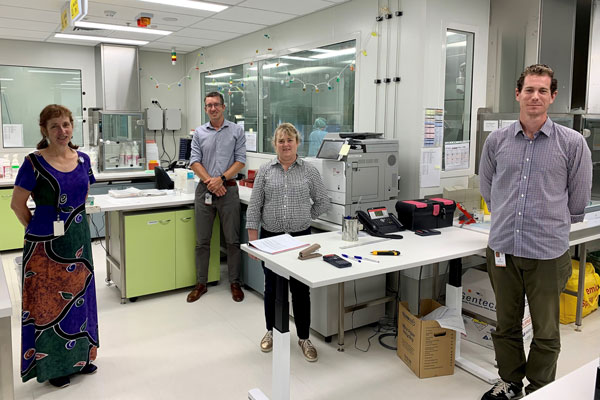
Just some of the team involved – Marissa Bartlett, David Pattison, Louisa Campbell and Jye Smith
The Royal Brisbane and Women’s Hospital (RBWH) Nuclear Medicine team recently went above and beyond to provide their highly specialised services for a very sick newborn baby in Sydney.
The baby was born with Congenital Hyper Insulinemia (CHI), a serious pancreatic condition which is notoriously difficult to treat. If the patient’s lesion is localised, then surgery is a complete cure. The challenge in this is identifying the localised lesion and also pinpointing its location, which is where the RBWH Nuclear Medicine team came in.
Positron Emission Tomography (PET) scanning is a type of medical imaging which uses radioactive substances, or tracers, to visualise and measure abnormalities in the body. The baby in Sydney required a highly specialised PET tracer called F-DOPA which is manufactured in a radio-isotope laboratory. RBWH was the first laboratory in Australia to manufacture this tracer successfully and is currently one of only two suppliers, the other being in Perth.
To ensure the baby received the medical treatment required, Sydney Children’s Hospital had planned to fly the baby to Brisbane so he could receive the PET scan. However, the RBWH Nuclear Medicine team saw an opportunity to manufacture the tracer in their lab and send it to Sydney so the baby could be treated locally.
The paediatric team in Sydney were thrilled with this, as it meant the baby could continue being treated in the hospital and avoid the complexities of being airlifted interstate.
RBWH Director of Nuclear Medicine William Fong said this was just the beginning of a very eventful 24 hours.
“The team worked from the early hours of the morning to manufacture the tracer in time to travel to Sydney. F-DOPA has a life-span of just eight hours before it expires, so once we manufactured it we needed to get it to Sydney as quickly as possible,” he said.
“Unfortunately, due to complications with the airline, the radioactive tracer was rejected by the plane and consequently couldn’t arrive in Sydney in time. Everyone was devastated, but we had one last chance to get it to Sydney.
“The entire team was back in the lab in the early hours the next morning manufacturing the new tracer. We had to rearrange patients and pull in staff to make it happen but thanks to the incredible teamwork displayed, the tracer was on its way to Sydney the next day.”
That afternoon, the tracer was able to be used in the baby and the urgent PET scans were performed with assistance from the RBWH team via telehealth.
The scans revealed where the lesion was in the baby, which was then successfully removed and the baby cured. The baby has since made a full recovery and is home.
Thank you to all staff involved for your dedication, quick thinking and commitment to helping not only our RBWH patients, but patients across the country.